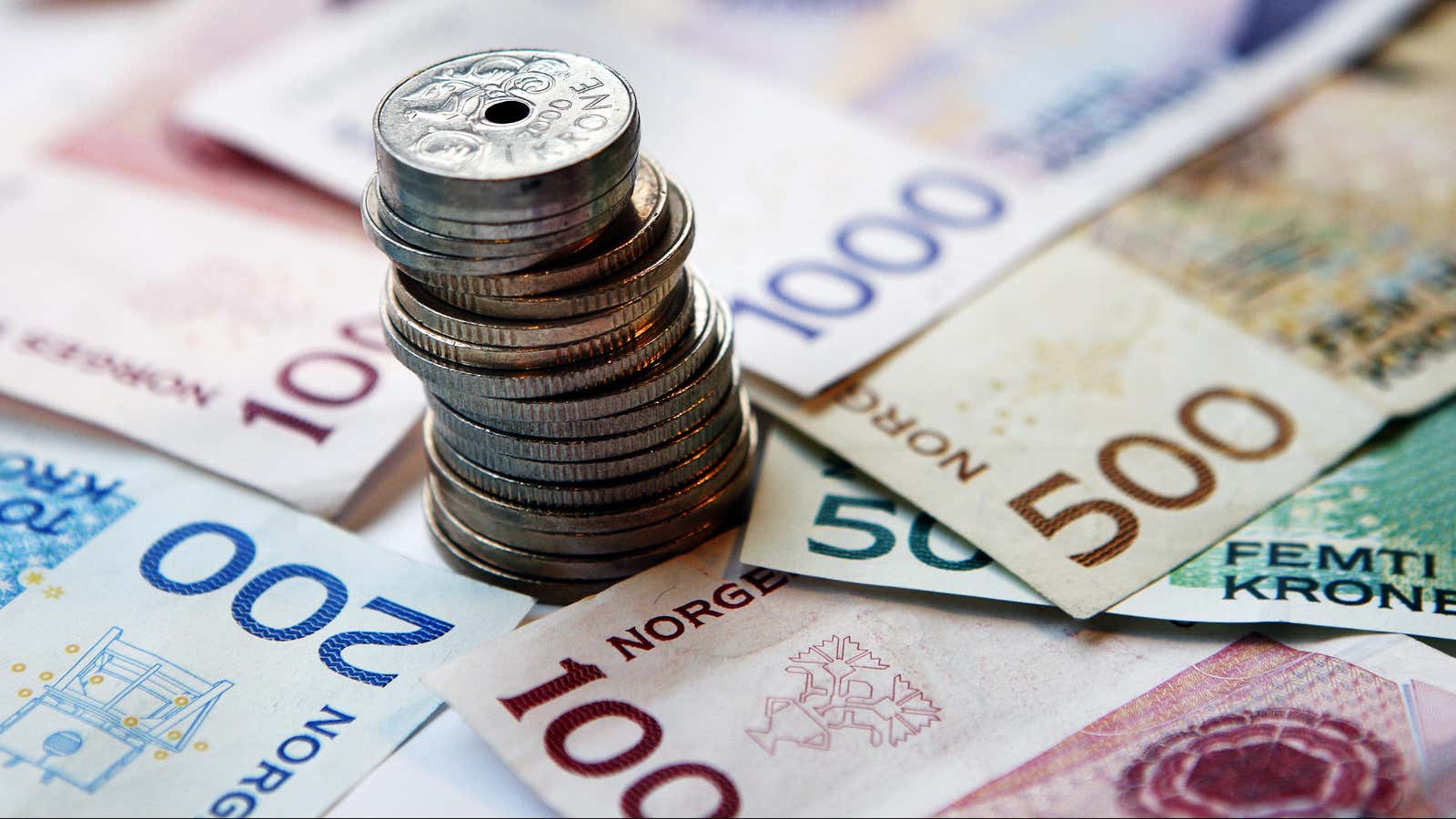The value of Norway’s sovereign wealth fund, fed on its oil and gas receipts, is growing so much faster than the country’s GDP that the Norwegian krone may well become the world’s first global currency. Not the world’s most important currency or a reserve currency like the US dollar, but the first currency whose value is determined largely by the movement of global markets and only minimally by its country’s economic activity.
This won’t make the krone itself a target for investors overseas. It isn’t liquid enough for that; there aren’t enough krone to go around. Nor will it become a bellwether; observing the krone and deducing which aspect of the world’s financial markets is influencing its fluctuations won’t be easy. But the expansion of the fund will make it into an investor of immense means, with a singular capacity to transform green energy, infrastructure, and other causes Norway cares about.
Since 1996, Norway’s oil fund—formally called the Government Pension Fund Global—has been investing fossil fuel revenues in fixed-income assets, equities, and real estate overseas, trying to build a financial reserve for its citizens in a post-oil future. On its website, the fund hosts a live ticker of its value, which now hovers around $1.3 trillion—making it the world’s largest sovereign wealth fund.
The oil fund owns more than 1.5% of all the listed stocks worldwide, and its returns alone were worth a third of Norway’s GDP in 2020—even amidst the pandemic. “It’s as if every Norwegian has a personal offshore investment portfolio of $240,000,” said Tor Vollalokken, a senior advisor at the New York-based investment analysis firm Exante Data.
Vollalokken, who has tracked the krone for decades, recently extrapolated both the oil fund and Norway’s GDP forward over 30 years, using past rates of growth as a guide. At the moment, the fund’s value is roughly three times that of the GDP. By 2030, the fund will near $9 trillion—more than 14 times the value of the GDP. By that point, the krone will undergo a dramatic shift.
How the krone will become a global currency
Every currency’s value is determined by its country’s economic activity and interest rates. Even the US dollar reflects, in large part, “the fair value of the US economy,” Vollalokken said. The krone used to additionally reflect the price of oil, but as Norway moves away from oil production, that correlation has faded. The oil fund’s investments are accounted in krone, so as its value outpaces that of Norway’s economic activity, the krone will increasingly reflect the movements in the fund’s investments.
There are already signs that the krone is more responsive to investments in the fund rather than the Norwegian economy, Vollalokken said. Since late 2019, for instance, the fluctuations in the value of the US dollar relative to the krone closely track those in the S&P 500. This particular period may still be a coincidence, he pointed out, but future trends may mirror this pattern closely—especially as the fund keeps buying equities.
This would put the krone into uncharted waters. Norges Bank, the country’s central bank, will manage the fund’s investments as it does now, but it will lose a measure of its ability to regulate the krone’s value. A slump in US equities will affect the krone—and by extension, inflation or deflation in Norway—more than a rise in interest rates at home. Norwegian companies will have to figure out how to transact in a currency that their government cannot easily influence.
How Norway could tame the krone’s volatility
The best that Norges Bank can do is muffle the krone’s volatility somewhat, Vollalokken said. One way is to look for more asset classes to invest in, drawing down the fund’s exposure to equities. At present, equities form 70% of the fund’s portfolio; if this remains unchanged and the fund grows, it may end up owning perhaps 5-10% of the world’s listed shares. (“I don’t even know what the international implications will be if this one fund owns 5-10% of all equities,” he said with a laugh. “Maybe that won’t even be considered acceptable.”) Since 2019, Norway has been looking to invest in green energy projects around the world. (The problem, the fund’s CEO said last year, is that it can’t find enough such projects.) “I see the fund also investing in big, big infrastructure projects, as a silent partner providing long-term funding,” Vollalokken said.
Last year, to pay for a pandemic stimulus, Norway made an all-time high withdrawal of $37 billion from the fund—barely 3% of its value. Norway is already able to fund a robust welfare state without dipping heavily into the fund: Its education is free and its healthcare heavily subsidized. Unemployment is low. More than half the population owns or has access to a second home.
As a result, the oil fund won’t shrink in a hurry. It was meant as a rainy-day reserve, and those days—long after oil—will certainly come. But well before that, if the recent past is any guide, the rainy-day reserve might dwarf Norway’s actual economy, giving the krone a quite unique status.
